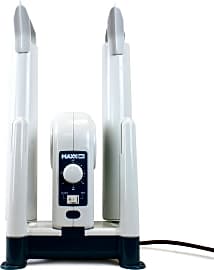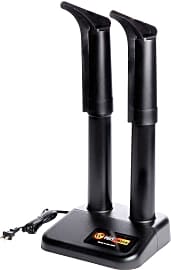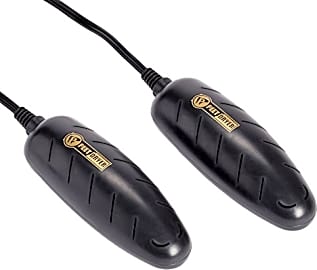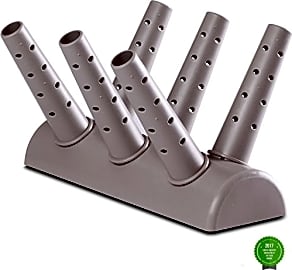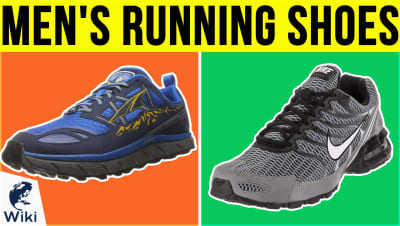The 10 Best Shoe Dryers

This wiki has been updated 39 times since it was first published in October of 2015. Few feelings are quite as unpleasant as placing a dry foot into a cold, wet boot. Using one of these shoe dryers, however, you can quickly expel the moisture from your footwear, gloves, or sports gear while eliminating unsavory odors and preventing the growth of bacteria at the same time. When users buy our independently chosen editorial picks, we may earn commissions to help fund the Wiki.
Editor's Notes
December 19, 2019:
Having a shoe dryer might seem like a luxury, unless you're a construction worker who sweats in work boots all day, someone who lives in a wintry climate abundant with rain, snow, and sleet, or an athlete who spends hours sweating in shoes, cleats, and skates. Those who deal with consistently wet footwear often have to contend with unpleasant odors, bacteria, and inconvenience. That's where shoe dryers come in handy, and we considered the myriad functions and needs users might have when re-ranking this list.
If your entire family needs gloves and shoes dried quickly and often, then the MaxxDry Heavy Duty, Peet Advantage, and Kendal SI-SD06G are all great choices. For personal use to warm up shoes before heading out the door or to quickly dry sneakers and cleats, items like the Peet Power Cell and Kooder Eliminate are ideal. Travelers will appreciate the portability of the foldable DryGuy 2207 and Manledio Electric. These two options have much in common, yet they sport different looks, price points, and dimensions to suit varying preferences.
We said goodbye to the MaxxDry XL since it seems to have no discernible differences in design and function to the already present MaxxDry Heavy Duty. We also let go of the HolaVa Warmer and Dr. Dry Electric due to deliverability concerns. We were able to add the effective and economically priced Kooder Eliminate and travel-friendly Manledio Electric in their wake.
We filled the vacancy left by the MaxxDry XL with the Kendal SI-SD06G, a powerful, effective option that can be wall-mounted and is easy to install. It's great for entryways and garages and is relatively quiet. However, its light humming makes it best suited to a room in which you do not need to study or sleep unless you like white noise.
Special Honors
Dry-X Inc. Custom Boot Dryers If you require a commercial-quality drying system for your home, a ski resort, locker room, and more, then consider inquiring with Dry-X Inc., a company founded by extreme skier George Fox. They build dryers that follow a no-heat philosophy to ensure the integrity of your gear, yet are still fast and efficient. These dryers are rigorously tested and use the highest quality materials available, and you can choose from residential, commercial, and mobile options. custombootdryers.com
Gear Dryer Wall Mount Ideal for a family home or lodge, the Gear Dryer Wall Mount boasts 200 CFM of forced airflow, an option to dry with heated or ambient air, self-regulating heater, five pre-programmed settings, and twist and lock design that allows for multiple configurations to accommodate various types of gear. It's made from heavy-duty steel with a durable powder coat finish, plugs into a standard 120V wall socket, and features twelve individual dryer ports that can hold up to six pairs of boots or gloves. geardryer.com
What To Look For In A Shoe Dryer
If you live in a busy household, where family members constantly need to dry and warm shoes one after another, make sure your model has a long operating life.
Before knowing what special features to look for in a shoe dryer, one should first have an understanding of how one works. All shoe dryers consist of air pipes that connect to a base. The base generates heat and air and sends it up through holes in the pipes. When you place the shoes on the pipes and turn the base on, they dry. Depending on your model, you can choose various temperatures. Some temperatures are good for simply drying shoes while others can keep your footwear warm until you're ready to wear it. Studies have even shown that specific temperatures can kill up to 90 percent of bacteria.
Some shoe dryers have digital screens that display the temperature, and the amount of time left until the footwear is dry. Many also let you set a timer, so they automatically shut off when your shoes are ready. Especially active individuals who sweat through a lot of footgear should look for a dryer with several pairs of air pipes so that they can dry more shoes at once. Some models have pipes that are shaped similarly to shoe horns, filling out every contour of a shoe. These are best for keeping shoes warm from toe to heel.
If you want to dry taller shoes like boots, look for a dryer with extension tubes to accommodate the extra material. If you live in a busy household, where family members constantly need to dry and warm shoes one after another, make sure your model has a long operating life. Since feet play a large role in temperature regulation, you don't want your dryer to shut down before everybody is happily in warm shoes.
Why Keeping Your Feet Dry Is Important
Many people believe that athlete's foot is caused by walking around a gym locker room barefoot. While there is some validity to that statement, since one's bare foot can come in contact with the fungus associated with this condition in a public area, it only covers part of the causes. Athlete's foot is often the result of wearing damp shoes, and not giving footwear enough time to air out before putting them back on. Fungus thrives in warm, moist regions like a sweaty shoe.
Common symptoms include skin that is itchy, dry, red, flaking, scaling, and even discoloring.
Athlete's foot is not that dangerous, but it is incredibly uncomfortable. Common symptoms include skin that is itchy, dry, red, flaking, scaling, and even discoloring. Since this is a fungal infection, and fungus spreads rapidly, it can, in fact, move to other parts of your body. So you can experience all of those same symptoms in very unpleasant regions, like your armpits and pelvic region.
While this condition is mostly associated with soldiers at war, trench foot can be caused by walking around in damp shoes, and it's very painful. Those who live in cold climates need to worry the most about this illness. If your feet are exposed to cold, damp conditions for an extended period of time, they can struggle to get the blood supply they need, and eventually the tissue in them can begin to die through a process called necrosis. Again, this mostly happens under extreme conditions, but it should be enough to discourage you from keeping boots on for hours after snow or rain has fallen inside of them.
In addition to using a shoe dryer to remove moisture and bacteria from your footwear, you should also avoid wearing thick socks. These can cause your feet to sweat too much inside of your shoes, ushering in moisture. Podiatrists say that shoes made from synthetic materials, like plastic and fake leather, as well as nylon socks, are some of the top causes of foot problems.
How To Keep Your Feet From Sweating In Shoes
Shoe dryers can help eliminate excess moisture and bacteria, but, ideally, you're taking steps to reduce sweating in your footwear, so you can fend off things like athlete's foot. Most people think of their underarms when they talk about antiperspirant, but you can actually apply deodorant to your feet, too. Antiperspirant spray for your feet is different from that for other parts of your body, though. It contains around 30 percent of aluminum chloride hexahydrate, while underarm varieties only contain 10 to 15 percent.
You can also try this home remedy for sweaty feet: Steep black tea bags in a large bowl of warm water and soak your feet in the mixture for a half an hour. The tannic acid in this particular tea can reduce sweating. If you're an avid athlete, make sure you wear proper running shoes made from materials that breathe so moisture doesn't become trapped inside of them. They are available in both men's and women's styles.
You can treat sweaty feet with items you have around your home, too, like baking soda. Either adding it directly to your shoes or soaking your feet in a solution of hot water and baking soda, has been shown to reduce sweating. Some people insert pieces of cedar into their shoes, because this absorbs moisture and sends out a pleasant smell.



